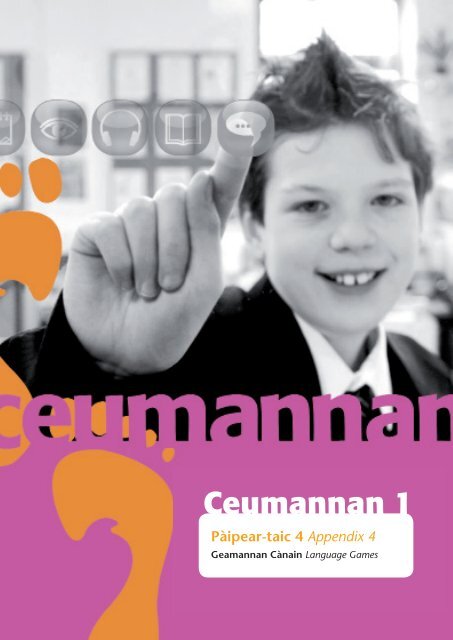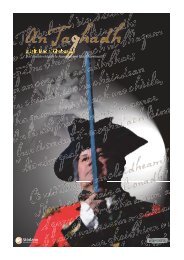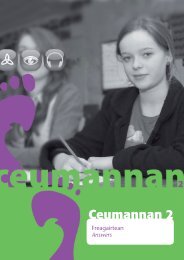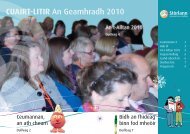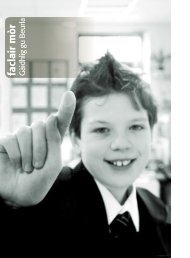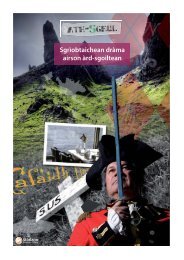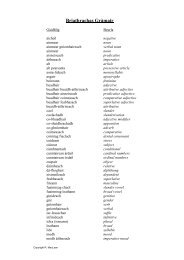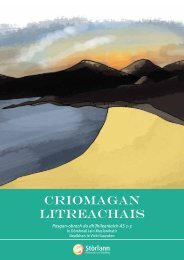Create successful ePaper yourself
Turn your PDF publications into a flip-book with our unique Google optimized e-Paper software.
cover page<strong>Ceumannan</strong> 1Pàipear-taic 4 Appendix 4Geamannan Cànain Language Games
2 <strong>Ceumannan</strong> 1 Pàipear-taic 4Geamannan CànainTha geamannan cànain an-còmhnaidh feumail ann an clas Gàidhlig. Chan eil nasgoilearan mothachail gu bheil iad a’ cleachdadh a’ chànain no gu bheil iad a’ cur ancuid sgilean gu feum. Tha iad gu h-àraidh feumail aig toiseach no deireadh leasainairson faclan no puingean cànain a dhaingneachadh. Chan fheum lethbhreacan adhèanamh de gach gèam; dh’fhaodadh am fiosrachadh a thaisbeanadh air clàr gealdhan a’ chlas air fad.Seo eisimpleirean de gheamannan a dh’fhaodar a chleachdadh:Modal 1-6Xs is OsCuir clàr Xs is Os air a’ chlàr gheal. Cuir an cuimhne a’ chlas mar a chluichear Xs is Os. An uairsin, cuir naoi faclan a tha an clas ag ionnsachadh an-dràsta sna bogsaichean:Mar eisimpleir:Beurla, Matamataig, Gàidhlig, Ealain, Creideamh, Cruinn-eòlas, Eachdraidh,Ceòl, SaidheansCuir an clas ann an dà sgioba agus iarr air aon sgioba facal a thaghadh agus seantans adhèanamh. Mar eisimpleir: Tha Matamataig furasta. Cha d’ fhiach Ealain. Tha Gàidhlig math!Chan fhaigh iad ach fichead diog airson seo a choileanadh.Ma tha iad ceart, iarr air duine aca comharra (X no O) a chur dhan bhogsa agus gheibh ansgioba eile cothrom an uair sin. Caillidh iad an cothrom ma tha iad nas fhaide na fichead diog.’S e a’ chiad sgioba a nì sreath de Xs no Os a bhuannaicheas.Noughts and CrossesThe teacher should draw a Noughts and Crosses grid on the board. Remind the class of the rules ofNoughts and Crosses. Then put a word in each of the nine spaces (these should be wordsthe class is currently learning). Put the class into two teams and ask one team to choose a wordand to make a sentence using that word. (Eg. Tha Matamataig furasta. Cha d’ fhiach Ealain.Tha Gàidhlig math!) They should only get twenty seconds in which to do this.If they are correct, one of the team should put an X or an O as appropriate in the box and theother side should then get a turn. The team will lose its turn if it takes longer than twenty seconds.The first team to get a line of Xs or Os wins the game.
3 <strong>Ceumannan</strong> 1 Pàipear-taic 4Modal 1 Aonad 1Am BallFeumaidh ball a bhith aig a’ chlas. Tha a h-uile duine ann an cearcall. Tha a’ chiad duine agràdh, “Is mise…” An uair sin tha am ball air a thilgeil gu cuideigin eile leis a’ cheist, “Dè ant-ainm a th’ ort?” Tha a’ cheist air a freagairt agus air adhart mar sin. Faodar ainmean ùra achleachdadh: “Is mise Mòrag Nic-a-phì.” “Is mise Calum Moireach.” Faodar cuir ri seo mar athèid iad tro na h-aonadan – “Tha mi a’ fuireach ann an…” “Is toigh leam…” “Tha dà phiutharagam…”The BallThe class should have a ball. Everyone should form a circle. The first person says, “Is mise…” Thenthe ball is thrown to someone else with the question, “Dè an t-ainm a th’ ort?” That question isanswered and the ball is thrown again to the next person. New names could be used: “Is miseMòrag Nic-a-phì.” “Is mise Calum Moireach.” This game can be added to as pupils progressthrough the units – “Tha mi a’ fuireach ann an…” “Is toigh leam…” “Tha dà phiuthar agam…”Guthan AnnasachTha sgoilear na shuidhe air beulaibh a’ chlas, a chùlaibh ris a’ chlas agus a shùilean dùinte.Feumaidh na sgoilearan eile gluasad gu àite ùr san rùm. Taghaidh an tidsear sgoilear airsontighinn a-mach agus seasamh air cùlaibh a’ chiad sgoileir. Feuchaidh an dara sgoilear ri ainmùr a thoirt seachad ann an guth annasach. Tha cead aig a’ chiad sgoilear iarraidh air an darasgoilear an t-ainm a ràdh dà thuras eile le bhith a’ cleachdadh “Gabh mo leisgeul.” An uair sin,feumaidh an sgoilear tomhas a dhèanamh air cò th’ ann.“An e Sìne a th’ ann?”“’S e Sìne a th’ ann.”Dh’fhaodar an gèam seo a chleachdadh le liosta ùr de dh’fhaclan às gach aonad.Funny VoicesA pupil sits in front of the class, with his back to the class and his eyes closed. The other pupilsshould move to a new seat in the room. The teacher should choose a pupil to come out and standbehind the first pupil. The second pupil should give himself a new name in a funny voice. The firstpupil can ask to have the name repeated twice more by saying “Gabh mo leisgeul.” Then the firstpupil must guess who it is.“An e Sìne a th’ ann?”“’S e Sìne a th’ ann.”If he/she guesses correctly then the second pupil should take a turn of sitting in the chair. If theguess is incorrect, a new pupil should be chosen to sit in the chair. The game can be played usingnew language from any of the units.
4 <strong>Ceumannan</strong> 1 Pàipear-taic 4Modal 2 Aonad 1PupaideanPuppetsDh’fhaodadh na sgoilearan pupaidean a dhèanamh a bhios gu feum dhaibh airson geamannancànain a chluich. Faodaidh iad na pupaidean a chleachdadh airson stiùiridhean a thoirt seachaddhan chlas: “Iain, seas!”/“A Mhàiri, fosgail an uinneag!”/“Cuiribh ur leabhraichean air falbh!”a’ cleachdadh ghuthan eadar-dhealaichte.The pupils could make puppets that will be useful when playing language games. They couldmake puppets to give commands to other people in class: “Iain, seas!”/“A Mhàiri, fosgail anuinneag!”/“Cuiribh ur leabhraichean air falbh!” using different voices.Ceistean, CeisteanDh’fhaodar pupaidean a chleachdadh airson ceistean sìmplidh fhaighneachd ann an càraid:Dè an t-ainm a th’ ort?Dè an aois a tha thu?Càit a bheil thu a’ fuireach?No dh’fhaodar aon phupaid a chleachdadh airson bruidhinn ris a’ chlas air fad. “Càit a bheilthu a’ fuireach, Anna?”/“Fosgail an doras, a Mhàrtainn!”/“Cuir dhìot do sheacaid, a Chaluim!”Dh’fhaodadh na sgoilearan turas mu seach a ghabhail air beulaibh a’ chlas. Tha nas lugha nàireair cuid de sgoilearan nuair a tha pupaid aca a bhruidhneas air an son!Questions, questionsPuppets could be useful to ask and answer simple questions in pairs:Dè an t-ainm a th’ ort?Dè an aois a tha thu?Càit a bheil thu a’ fuireach?One puppet could be used to ask various members of the class questions. Càit a bheil thua’ fuireach, Anna?”/“Fosgail an doras, a Mhàrtainn!”/“Cuir dhìot do sheacaid, a Chaluim!”Pupils could take turns of using the puppets in front of the class. Less confident pupils will be lessembarrassed to speak when they have a puppet to speak on their behalf!
5 <strong>Ceumannan</strong> 1 Pàipear-taic 4Modal 3 Aonad 1Dè an t-aodach a th’ ort?Tha a h-uile duine a’ coiseachd mun cuairt a’ coimhead air aodach chàich. Dh’fhaodar ceòla chluich sa chlas aig an aon àm. Nuair a stadas an ceòl, feumaidh na sgoilearan an uair sinseasamh cùl ri cùl ris an duine as fhaisge. Feumaidh iad faighneachd ann an Gàidhlig dè ant-aodach a th’ air an duine sin:A: A bheil seacaid ghorm ort?B: Chan eil seacaid ghorm orm.Leanaidh iad orra gus an dèan iad tomhas ceart agus an uair sin, tòisichidh iad a-rithist.What are you wearing?Everyone should walk around looking at what others are wearing. Music could be played in the classat the same time. When the music stops, pupils must stop and stand back to back with the pupilnearest to them. They must ask in Gaelic what the other person is wearing:A: A bheil seacaid ghorm ort?B: Chan eil seacaid ghorm orm.They should carry on until they guess correctly and then start again.A’ ChisteBogsa mòr le aodach eadar-dhealaichte ann – dh’fhaodar iarraidh air na sgoilearan stuth a thoirta-staigh – mar as èibhinne an stuth, ’s ann as fheàrr. Tha a’ chiad sgoilear a’ tighinn a-machagus tha cuideigin bhon chlas ag iarraidh air an sgoilear pìos aodaich a chur air. “Cuir ort còta!”Feumaidh an sgoilear sin a lorg sa chiste, sin a chur air agus an uair sin “Tha còta orm!” a ràdh.’S dòcha gum bi aca ri seo a dhèanamh taobh a-staigh leth-mhionaid no mar sin. Tha seoa’ leantainn air adhart gus am bi aodach eadar-dhealaichte air a h-uile duine. Faodaidh nastiùiridhean a bhith nas mionaidaiche: “Cuir ort seacaid ghorm!”The CaseThe teacher should organise a big box or case containing different clothes – pupils could be asked totake in various items – the funnier the better! The first person comes out and one of the other pupilsasks him/her to put on an item of clothing from the chest: “Cuir ort còta!” The pupil must find thatin the chest, put it on and then say: “Tha còta orm!” This goes on until each pupil has on a differentitem of clothing. The commands could be more detailed: “Cuir ort seacaid ghorm!”
6 <strong>Ceumannan</strong> 1 Pàipear-taic 4Modal 4 Aonad 1Làithean na SeachdainCluich na trì geamannan seo còmhla ri caraid.Play these three games with a partner.You will need to use (or make) a set of game cards. Each card will have a different day of theweek written on it, one set in Gaelic and another in English. You could also play the game witha set of month cards, school subjects, place names etcMix ‘n’ match – spread out the cards face up and mix them all up. Take turns to choose acard and then find its matching pair.Mar eisimpleir:• Ceart no ceàrr? – Place all the cards in a pile, face down. Take turns to choose a cardbut don’t let your partner see it. Translate the word on the card and say the translatedword to your partner (Mar eisimpleir: if your card has the word Diluain on it youshould say ‘Monday’). Your partner must give the translation of that word to you(Mar eisimpleir: Diluain). If the word your partner gives you is identical to the onewritten on your card then s/he is ceart. If not, then one of you is ceàrr! Show the cardto your partner and tell your partner if he/she was ceart or ceàrr.• Memory Pairs – Place the cards face down and spread them out. Take turns to turnover two cards. Say the words on the cards you turn over. If you turn over two matchingcards, you keep that pair to one side. If they don’t match, you must turn them back over.Try to remember where each card is so that you can match them up next time. When allthe pairs are matched up, count your sets of pairs to see who wins.
7 <strong>Ceumannan</strong> 1 Pàipear-taic 4Modal 4 Aonad 2Cuin a tha do cho-là-breith ann?Feumaidh a h-uile duine seasamh. Feumaidh an clas loidhne a dhèanamh a rèir cuina tha an co-là-breith aca ann. Feumaidh iad faighneachd dha chèile, “Cuin a tha docho-là-breith ann?” Freagraidh daoine le “Tha mo cho-là-breith san Dàmhair.”, mareisimpleir. Ma tha co-là-breith aig barrachd is aon duine air an aon mhìos, feumaidh daoinebarrachd fiosrachaidh a thoirt seachad airson an loidhne fhaighinn ceart. Nuair a tha gachduine deiseil, iarraidh an tidsear air a h-uile duine innse cuin a tha an co-là-breith aca ann.The whole class should stand. The class should form a long line showing people’s birthdays,beginning with the earliest in the year. The class must ask each other in Gaelic in order to get theline right, “Cuin a tha do cho-là-breith ann?” Pupils will answer like this: “Tha mo cho-là-breith sanDàmhair.” If more than one pupil has a birthday in the same month, more information (the date)should be given. When you are ready, the teacher will ask all pupils to state when their birthdaysare, beginning with the first birthday of the year, to check the line is in the correct order.Modal 4 Aonad 3Ag innse na h-uarach1 Feumaidh tu cloc no pàipear agus peansail. Èist ris an tidsear ag innse nah-uarach agus cuir spògan a’ chloc anns an àite cheart no sgrìobh an uair.Innsidh e/i dhut ma tha thu ceart no ceàrr.You will need a play clock or paper and a pencil. Listen as your teacher tells you some times inGaelic. Set the hands on your clock or write each one in English. He/she will tell you if you areceart or ceàrr.2 Seallaidh an tidsear diofar uairean air a’ chloc dhan chlas no nì e/i dealbh aira’ bhòrd gheal. Faighnichidh e/i “Dè an uair a tha e?” Inns an uair dha/dhiagus innsidh an tidsear dhut ma tha thu ceart no ceàrr.Your teacher will set the hands on the class clock/draw some times on the board. He/she willask “Dè an uair a tha e?” Tell him/her the time in Gaelic. He/she will tell you if you are ceartor ceàrr.3 Feuch an aon rud a-nis còmhla ri caraid. Gabh turas mu seach.Now try doing the same as above but with your partner. Take turn about.4 Sgrìobh diofar uairean ann am Beurla no figearan airson do charaid.Feumaidh do charaid an sgrìobhadh ann an Gàidhlig. Nì ise/esan an aon ruddhut fhèin. Ceartaich obair a chèile an dèidh làimhe.You and your partner are going to test each other on times. Write a list of some times infigures or in English for your partner. Your partner will have to write the Gaelic for each one.He/she will do the same for you. Swap at the same time and see who is quickest to finish.
8 <strong>Ceumannan</strong> 1 Pàipear-taic 45 Dè an uair a tha e, a Mhadaidh-allaidh?’S cinnteach gum bi a’ chlann eòlach air a’ gheàm seo bho raon-cluiche na bun-sgoile.Feumar sèithrichean is bùird a chur gu oir an rùim no a dhol a-mach airson an gèam seoa chluich. Tagh sgoilear (am madadh-allaidh) airson seasamh aig aon cheann den rùm,a chùl ri càch (na cearcan). Bidh na cearcan nan seasamh aig ceann eile an rùim. Bidhiadsan ag èigheach, “Dè an uair a tha e, a Mhadaidh-allaidh?” Bidh am madadhallaidhag innse na h-uarach (uair sam bith). A rèir dè an uair a dh’innseas am madadhallaidh,feumaidh na cearcan an aon uiread de cheumannan a ghabhail ga ionnsaigh.Leanaidh seo air adhart gus am bi na cearcan gu math faisg air a’ mhadadh-allaidh. (Madh’fhanas iad sàmhach agus ma ghabhas iad ceumannan beaga tha e nas dorra dhanmhadadh-allaidh obrachadh a-mach a bheil iad faisg gu leòr air airson an glacadh). Bidham madadh-allaidh a’ taghadh cuin a dh’èigheas e “Àm dinneir!” agus e a’ tionndadhmun cuairt agus a’ feuchainn ri grèim fhaighinn air na cearcan. Feumaidh an fheadhainna thèid a ghlacadh suidhe sìos. Bidh na cearcan sàbhailte cho luath ’s gum beir iad aira’ bhalla aig cùl a’ chlas, far an do thòisich iad. Bidh fuaim ann gun teagamh sam bith!Ma tha Gàidhlig aig tidsear Spòrs san sgoil, ’s dòcha gun cluicheadh iad seo sa chlasSpòrs. Ach, tha an cànan cho furasta, chan fheum an tidsear Spòrs a bhith fileanta –dìreach deònach beagan Gàidhlig ionnsachadh/a chleachdadh airson tuigsinn na thaa’ dol air adhart!What’s the time Mr Wolf?Pupils will have played this game before in primary school. Clear desks and chairs - or, even,better, play outside! Choose a pupil (Mr Wolf). He/she should stand at one end of the roomwith the rest of the class (the chickens) at the other end. The chickens should shout: “Dè anuair a tha e, a Mhadaidh-allaidh?” The wolf makes up a time and calls it back. The timegiven will indicate the number of steps the chickens must take towards the wolf. This willcontinue until they get quite close to Mr Wolf. If the chickens are silent and take little steps,they will have a better chance of survival! Mr Wolf will choose when he answers the chickenswith “Àm dinneir!” and he turns round to catch as many chickens as possible. The chickenswill be safe if they can touch the other wall without being caught. Prepare for noise!If the PE teacher has Gaelic, the pupils might be able to play this in PE. But the language is sosimple that fluency is not essential - just some patience and understanding required!6 Cuin a tha thu… ?Obraich ann am buidheann/còmhla ri caraid. Cuin a tha daoine a’ dèanamhrudan?You are going to talk with your group/partner about daily routine. Find out when they docertain things. Who gets up earliest? Who is the latest to bed? Use as much new vocabularyas you can. When you have finished, you could report back to the class about some of theinformation you found out.
9 <strong>Ceumannan</strong> 1 Pàipear-taic 4Mar eisimpleir:Tha Jason ag èirigh mu sheachd uairean sa mhadainn ach tha Sandra agèirigh aig cairteal an dèidh ochd.Jason gets up about 7 am but Sandra gets up at 8.45.7 A’ cluich le gnìomhaireanCluich na geamannan seo ann am buidheann no còmhla ri caraid. Gabh turas mu seach.A. Tagh gnìomhair agus inns dhan bhuidhinn dè an gnìomhair a th’ ann. Mareisimpleir: danns, leum, seinn, èist, leugh… Feumaidh càch seo actadha-mach. Inns dhaibh a bheil iad ceart no ceàrr.Say a verb to your group/partner. They should act it out to show that they understand it.Tell them if they are ceart or ceàrr.B. Tagh gnìomhair agus leig ort gu bheil thu a’ dèanamh an rud. Feuchaidh docharaidean ri obrachadh a-mach dè tha thu a’ dèanamh. Faighnichidh iad“A bheil thu...?” Inns dhaibh a bheil thu a’ dèanamh an rud a thomhais iad.In your group or with a partner, take turns to act out some verbs. The others/your partnershould guess what you are doing by asking “A bheil thu...?” Answer the question with either“Tha mi...” or “Chan eil mi...” Keep miming your chosen verb until they guess correctly.C. <strong>Ceumannan</strong>Tha seo coltach ri Consequences ann am Beurla. Obraich ann an càraid.Feumaidh gach duine pìos pàipeir agus peann no peansail. Sgrìobh ainmduine (fear ainmeil no sgoilear eile – chan eil e gu diofar cho fad ’s a thueòlach air). Na leig le do charaid na sgrìobh thu fhaicinn. Paisg am pàipearagus thoir dha do charaid e. Air a’ phàipear a fhuair thu, sgrìobh ainmboireannaich no sgoileir eile. Paisg am pàipear agus thoir dha do charaida-rithist e. Sgrìobh càit an do choinnich iad. Paisg am pàipear agus thoirdha do charaid a-rithist e. Sgrìobh dè thuirt an duine nuair a choinnich iad.Paisg am pàipear agus thoir dha do charaid a-rithist e. Sgrìobh dè thuirtam boireannach nuair a choinnich iad. Paisg am pàipear agus thoir air aisa-rithist e. Sgrìobh dè an t-aodach a bh’ air. Paisg am pàipear agus thoir dhado charaid a-rithist e. Sgrìobh dè an t-aodach a bh’ oirre. Paisg am pàipearagus thoir dha do charaid a-rithist e. Sgrìobh dè thachair aig an deireadh.Paisg am pàipear agus thoir dha do charaid a-rithist e. Nise, fosgail napàipearan agus leugh a-mach iad. Bu chòir dhaibh a bhith èibhinn!This game is the same as Consequences in English. Work with a partner. You will both needpaper and a pen. Write the name of a man or a boy you know. Don’t let your partner seewhat you’ve written. Fold the paper and hand it to your partner. He/she should write awoman/girl’s name, fold the paper and hand it back. Now write in Gaelic where they met,fold the paper and hand it back. You should then write what he said and hand it back. Nowwrite what she said and hand it back. Write what he wore and hand it over. Write what shewore and hand it back. Write the consequences/outcome of the meeting – try practising thepast tense. What happened? Fold and hand over. You should then read out your stories –they should be funny.
10 <strong>Ceumannan</strong> 1 Pàipear-taic 4Modal 5 Aonad 1A. Dèan dealbhTha an geàm seo coltach ri Pictionary. Dèan dealbh de dh’obair. Feumaidhan clas tomhas dè an obair a th’ ann.Draw the sign for either male or female. Draw a sketch for a job on the whiteboard. The classwill try and guess which job it is, asking “An e... a th’ ann?” or “An e... a th’ innte?” Theperson who guesses correctly takes the next turn.B. Dèan balbh-chluich!Leig ort gu bheil thu ag obair. Feumaidh an clas/a’ bhuidheann tomhas dèan obair a th’ agad, a’ faighneachd “An e ... a th’ annad?”Mime a job! The class/group must try to guess what job you have by asking, “An e... ath’ annad?” Keep miming until they guess correctly.C. SteigearanFeumaidh sibh steigearan bàna airson seo a chluich. Sgrìobh obair air ansteigear agad ann an Gàidhlig. Na leig le duine seo fhaicinn. Steig seo airceann cuideigin sa chlas. Feumaidh iad tomhas dè an obair a th’ aca.You will need little stickers or Post-its to play this game. Write the Gaelic word for a job on asticker. Stick it on another class member’s forehead so that everybody else in the group cansee it. Each group member should have a different sticker on. Take turns to ask questions toguess what job you have by asking “A bheil mi ag obair ann an ..?” “An e ... ath’ annam?”. If you get it wrong then it’s the next person’s turn. If you get the answer right,you may ask another question until you guess the job correctly.D. Obair, obairTha a h-uile duine ann an cearcall agus aon duine a’ tòiseachadh le bhith agràdh, “Is mise Dòmhnall agus ’s e dràibhear a th’ annam.” Tha an ath duineag ràdh, “Seo Dòmhnall. ’S e dràibhear a th’ ann. Is mise Catrìona.’S e tidsear a th’ annam.” An uair sin, “Seo Dòmhnall agus ’s e dràibhear ath’ ann. Seo Catrìona. ’S e tidsear a th’ innte. Is mise Iain. ’S e meacanaig ath’ annam.” gus am faigh a h-uile duine cothrom.Faodar atharrachaidhean a dhèanamh air seo: “’S e dràibhear a th’ annam.Tha mi ag obair anns a’ bhaile.” “’S e tidsear a th’ annam agus tha mi agobair ann an sgoil.”Everyone in a circle. One person starts by saying:“Is mise Dòmhnall agus ‘s e dràibhear a th’ annam.” The next person says, “Seo Dòmhnall.‘S e dràibhear a th’ ann. Is mise Catrìona. ‘S e tidsear a th’ annam.” Then, “Seo Dòmhnall.‘S e dràibhear a th’ ann. Seo Catrìona. ‘S e tidsear a th’ innte. Is mise Iain. ‘S e meacanaiga th’ annam.” until everyone has had a turn.There can be different versions of this: “‘S e dràibhear a th’ annam. Tha mi ag obair annsa’ bhaile.” “’S e tidsear a th’ annam agus tha mi ag obair ann an sgoil.”
11 <strong>Ceumannan</strong> 1 Pàipear-taic 4Modal 5 Aonad 2Cluich na geamannan seo còmhla ri caraid(ean). Feumaidh sibh cairtean le faclan aguscairtean le dealbhan pheataichean orra.Play these games with a partner or group. You will need a set of word cards and a set ofpicture cards for pets.A. DealbhanTog cairt le dealbh oirre.Can am facal ceart airson an deilbh.Feumaidh càch balbh-chluich no fuaim peata a dhèanamh.Inns dhaibh a bheil iad ceart no ceàrr.Lift a card. Say the word on the card. One of the groups should do a mime or make thesound of the pet. Tell him/her if he/she is right or wrong.B. FaclanTog cairt le facal oirre.Dèan balbh-chluich no fuaim airson a’ pheata.Feumaidh càch am facal ceart a ràdh airson a’ pheata.Inns dhaibh a bheil iad ceart no ceàrr.Lift a picture card. Do a mime or make a pet noise. The others must guess which it is andgive you the card. Tell him/her if he/she is right or wrong.C. Dealbhan agus faclanCluich an gèam Pàidhrichean.Cuir dealbhan agus faclan còmhla.Play the game Pairs. Put words and pictures together.D. A bheil ... agad?Tog cairt!Na seall do dhuine i!Na dèan balbh-chluich no fuaim!Feumaidh càch tomhas dè am peata a th’ agad le bhith a’ faighneachd“A bheil ... agad?”Lift a card. Don’t show it to anyone. Don’t do a mime or a sound. The others must guesswhich card you have by asking, “Do you have…?E. Dè th’ annam?Cuir ainmearan air cairtean – mar eisimpleir, beathaichean agus cuir cairtair druim gach duine. Feumaidh iad tomhas dè tha air an druim le bhitha’ faighneachd cheistean mar “An e cù a th’ annam?” agus an duine eilea’ freagairt, “’S e cù a th’ annad./Chan e cù a th’ annad.” gus an tomhaisa h-uile duine dè tha sgrìobhte orra. Dh’fhaodar seo a chleachdadh leobraichean ann am Modal 5 Aonad 1 cuideachd.Put nouns on cards – animals, for example – and put a card on each pupil’s back. Theymust guess which animal they are by asking questions like “An e cù a th’ annam?” andsomeone will answer, “’S e cù a th’ annad.”/“Chan e cù a th’ annad.” until everyoneknows which animal he/she is. This could also be used for jobs in Modal 5 Aonad 1.
12 <strong>Ceumannan</strong> 1 Pàipear-taic 4F. Abair coltas!Tha seo math mar ghèam èisteachd. Faodaidh an tidsear tuairisgeul adhèanamh de chuidegin. Cha bu chòir dha a bhith fìor idir. Feumaidhpìos pàipeir a bhith aig a h-uile duine sa chlas. Feumaidh an tidsear antuairisgeul a leughadh dhan a’ chlas trì tursan. Nì gach sgoilear dealbh dena rudan a chluinneas iad. Bu chòir dhan tidsear taghadh a dhèanamh aircò as fheàrr air feum a dhèanamh dhen fhiosrachadh. Faodar rudan marcholtas, teaghlach, peataichean, obair, cuspairean sgoile agus cur-seachadanainmeachadh. Faodaidh sgoilearan turas a ghabhail de bhith a’ leughadhtuairisgeul a chruthaich iad fhèin.Mar eisimpleir:Seo mo nàbaidh Ceiteag. Chan eil i beag, tha i gu math mòr. Tha i a’ fuireachann an Dùn Èideann. Tha i crosta. Tha i ochd-deug agus tha i ag obair annam bùth. Tha i reamhar agus tha còta mòr, ad agus bòtannan oirre. Is toighle Ceiteag a bhith a’ bruidhinn ri a caraidean air a’ fòn ach chan eil i idirmath air ball-coise. Tha dà chù agus coineanach aice. Chan eil Ceiteag idirmath air seinn.This is a good listening game. The teacher should make up a description of a fictionalcharacter. Each class member should have a piece of paper. The teacher should read thedescription to the class three times. Each pupil will draw a picture of what he/she hasheard. Ideally, the pictures should be pinned up somehere where they can all be seen.The teacher should decide which one best fits the description. The description could includethings like appearance, personality, family, pets, work, hobbies etc. Pupil should be given theopportunity to take turns reading out descriptions they create themselves.
13 <strong>Ceumannan</strong> 1 Pàipear-taic 4Modal 6 Aonad 1A. Taigh-bìdh AnndraObraich ann am buidheann.Leugh an clàr-bìdh.Cleachd na faclan feumail anns an aonad.In a group, you will be acting out some restaurant scenes. Choose the waiter and the diners.Make sure you know what is on the menu. Use the useful vocabulary in the unit.Customers• Read the menu.• What do you want to eat and drink?• Tell the waiter what you want.• Be prepared with a second choice in case something is not available.• Be ready to tell the waiter that you like/don’t like the food, and why.Waiters• Read the menu.• Pick up an order form.• Check with the kitchen (your teacher) what’s not available today.• Greet your customers politely.• Ask them what they want (every course and drinks).• Write down the information in English.• During each course, ask if they like the food.If they don’t, ask why not and say you are sorry.Taigh-bìdh AnndraClàr-bìdhAn toiseach MìlseanBrot tomàto Cèic seòclaidPaté le tost donn Paidh ubhailSailead càise Briosgaidean le càiseMeasanAnnlan DeochanPiotsa Sùgh orainseirIsbeanan is buntàta Sùgh liomaidMacarònaidh càise CòcIasg is sliseagan UisgeStaoig is sliseagan BainneCearc ròsta le glasraich Tì/cofaidh
14 <strong>Ceumannan</strong> 1 Pàipear-taic 4Taigh-bìdh AnndraÒRDAINAinm Ag iarraidh... Is toigh Cha toigh123Deoch123Deoch123Deoch123DeochBi adh blasta
15 <strong>Ceumannan</strong> 1 Pàipear-taic 4B. RannsachadhTha Taigh-bìdh Anndra ag iarraidh bheachdan air biadh agus seirbheis.Lìon am foirm le do bheachdan.Taigh-bìdh Anndra wants to make sure its customers are happy with the food and service.They give out a survey form to customers after their meal. Fill in your form. When you havefinished, hand it to your waiter.Taigh-bìdh AnndraAinm an neach-frithealaidh: ————————————————————————SeirbheisSgoinneil Math Dona Uabhasach Beachdan eileMar eisimpleir:Chòrd e rium.Tapadh leibh.AntoiseachAnnlanMìlseanDeochClàr-bìdhAn uair a tha sibh uile deiseil, bruidhinn ris a’ chlas mun taigh-bìdh.When all the groups have finished, discuss the restaurant with the rest of the class.Was your waiter polite? How was the food? Did you enjoy your trip to Taigh-bìdh Anndra?
16 <strong>Ceumannan</strong> 1 Pàipear-taic 4C Dè phrìs a tha am peansail?Obraich còmhla ri caraid. Cruinnich diofar rudan sa chlas – leabhar, peansail,seacaid... Tha do charaid airson na rudan a cheannach. Dè a’ phrìs a thagach rud? Inns a’ phrìs ann an Gàidhlig. Sgrìobhaidh do charaid a’ phrìs.A bheil e/i ceart no ceàrr?Collect some items and pictures you know the Gaelic for. You will also need some price tags(little pieces of paper or stickers). Make up some prices for the items. Your partner should askyou the price of each item in turn. He/she should label the item with the price you give. Tellyour partner if he/she is ceart or ceàrr. Give some encouragement and praise (in Gaelic!) ifthe prices are all correct. Swap roles.D Am Fear DallDè am biadh a th’ ann? An e ... a th’ ann? A bheil e blasta?Your teacher should put together an assortment of food items. Arrange yourselves intosmall teams. Each team member should take turns being blindfolded. He/she will be givensomething to touch, taste or smell. If he/she guesses correctly the team gets a point. If theteam can correctly spell the item they will receive a bonus point.Make sure you are aware of any food allergies first.Reasabaidhean Gàidhlig (Cultar)In the Cultar section of Modal 5 Aonad 2, you learned that in earlier times people of theHighlands and Islands had a simple, but healthy diet. Here you will find some simple traditionalrecipes that you could try out for yourself at home or in school.• Of course, in the olden days, nothing was weighed – everything was measured in spoonsand handfuls.• You’ll notice that there aren’t long lists of ingredients compared to modern recipes. Theyused only what was available to them.• Perhaps you could get the Eaconamas Dachaigh Department to help with one of therecipes. Your teacher could call out the method in Gaelic: “Dèan sin! Cuir ugh dhanbhobhla! Èistibh!”Siuthad! Nìgh do làmhan agus cuir ort aparan!
17 <strong>Ceumannan</strong> 1 Pàipear-taic 4Aran-coirce/OatcakesIngredients100g oatmeal12½g lard¼ teaspoon salt1 teaspoon bicarbonate of soda150ml boiling waterMethod1. Mix the oatmeal, salt and bicarbonate of soda.2. Melt the lard.3. Mix the lard with the oatmeal.4. Pour in the boiling water, a small amount at a time, mixing all the time.5. Leave for five minutes until the mixture blends together properly.6. Dust a board with a little oatmeal. Roll out the mixture to a thickness of about ½ cm.7. Cut with a knife into any shape or size.8. Put the oatcakes on a baking tray.9. Put them in a heated oven at 200c for 12–15 minutes.10. Nuair a tha iad air fàs fuar, ith le ìm, càise no gruth!Math, math!Is toigh leamaran-coirce le càise!
18 <strong>Ceumannan</strong> 1 Pàipear-taic 4Sgonaichean/SconesIngredients200g plain flour1 teaspoon cream of tartar1 ½ teaspoon bicarbonate of soda25g margarine1 eggAbout 3 tablespoons of milkMethod1. Mix the flour, cream of tartar, soda and margarine with your fingers.2. Make a small hole in the middle of the mix.3. Put the milk and the egg into the hole.4. Mix with your fingers until the dough comes together.5. Put the dough on a baking tray in the shape of a big circular scone.6. Put the scone in a heated oven for 10 – 15 minutes at 200⁰C.7. Allow the scone to cool. Cut it into triangles.8. Ith le ìm, càise, silidh no uachdar!Mmm!Tha mi ag iarraidh sgonale silidh is uachdar.Blasta!
19 <strong>Ceumannan</strong> 1 Pàipear-taic 4Brochan/PorridgeIngredients½ pint water50g oatmeal¼ teaspoon saltMethod1. Bring the water to the boil in a pot.2. Mix the oatmeal into the water, a small amount at a time, stirring constantlywith a wooden spoon.3. Turn the heat down low.4. Simmer for about 30 minutes.5. Add salt.6. Ith le bainne, uachdar no measan!Ò, brochan lom,tana lom …


